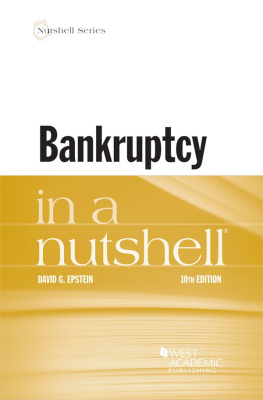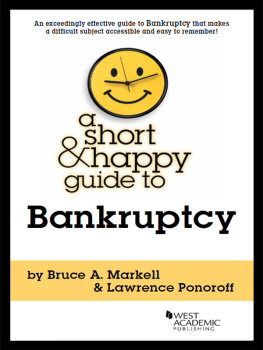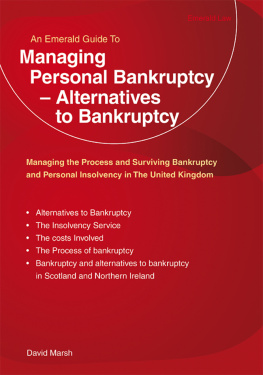AMERICAS TICKING
BANKRUPTCY
BOMB
HOW THE LOOMING DEBT CRISIS
THREATENS THE AMERICAN DREAM
AND HOW WE CAN TURN THE TIDE
BEFORE ITS TOO LATE
PETER FERRARA

For my son, Peter,
and all the young patriots of his generation
who will raise up a new vision of freedom
and prosperity for America
and the world.
Contents
Chapter 1 - Lighting the Fuse
How We Started Down the Road to National Insolvency
Chapter 2 - Americas Coming Bankruptcy
The Overwhelming Swirl of Deficits, Debt, and Unfunded Liabilities
Chapter 3 - The Baby Booms Retirement Bomb
Personal Account Prosperity for All
Chapter 4 - Obamacare: Death and Taxes
Repeal and Replace with Patient Power
Chapter 5 - The Welfare Empire
Liberate the Poor and Taxpayers
Chapter 6 - The End of the American Dream?
How the Government Caused the Financial Crisis
Chapter 7 - The Prosperity of Freedom
Lets Get America Booming Again
Chapter 8 - Failed States
Renewing Prosperity for Your State
Chapter 9 - The Equality of Freedom
Equality of Rules Versus Equality of Results
Chapter 10 - New Labor: Prosperity Unions
Power to the People for Working Families
Chapter 11 - The New Civil Rights
Economic Empowerment
Chapter 12 - The Rebirth of America
More Free and Prosperous Than Ever
Chapter 1
Lighting the Fuse
How We Started Down the Road to National Insolvency
The failures of federal, state, and local officials of both major parties, over many years, have primed a ticking bankruptcy bomb for America that will explode the American Dream if we do not disarm it. But it is not too late to reverse course and avert the coming bankruptcy of America. That will require fundamental structural reforms of all levels of government, and our most politically sensitive entitlement programs. If we do this right, thoroughly modernized entitlements will serve the poor and most vulnerable among us far better, and a new economic boom will restore Americas traditional world-leading prosperity. How to achieve those goals is explained in this book.
By the end of President George W. Bushs eight years in office, America had abandoned every one of the four major planks of Reaganomics, as explained in Chapter 6. While in his recent book, Decision Points , Bush insists that federal spending on average during his two terms was lower than for previous presidents, a lower average for eight years of spending trending up may not be a better record than a higher average for eight years of spending trending down. During Bushs eight years as president, the federal government grew by one-seventh relative to the economy, after the Republican Congress under former Speaker Newt Gingrich had so promisingly reduced it by that much from 1994 to 2000.
But when President Barack Obama got behind the steering wheel in 2009, he accelerated into hyperdrive even more so in all the wrong directions, doggedly pursuing the opposite of Reaganomics in every detail, as also explained in Chapter 6. Federal spending has already soared by another fourth relative to the economy, to the highest in history except during World War II. The national debt, now rocketing toward $20 trillion by 2020, is already the highest in history as a percent of gross domestic product (GDP) except for World War II, and on its current course will soar well past that record. Indeed, the national debt has been rising so fast that under current policies more debt will be run up in one term under President Obama than under all other presidents in historyfrom George Washington to George W. Bushcombined.
On our current course, indeed, our national debt as a percent of GDP will exceed even the level that triggered bankruptcy for Greece, when the financial markets refused to lend the government enough money to cover its enormous annual deficit. The European Union tried to end that crisis with a trillion-dollar bailout financed by its taxpayers. But who will bail out America? Who even could?
Even worse, the national debt does not nearly encompass everything the federal government owes, or on which it is subject to liability or further financial losses. According to official U.S. government reports, the long-term unfunded liability of Social Security is $15 trillion. If we add in all of Medicare, Parts A, B, C, and D, the total unfunded liabilities for these programs alone climbs to over $100 trillion, or about seven times todays entire economy.
Usually overlooked are the unfunded liabilities of federal military pensions, estimated at $3.7 trillion.
The Federal Deposit Insurance Corporation (FDIC) reports a negative reserve for deposit insurance coverage for $5.4 trillion in insured deposits.
Then there are trillions more in mortgage-backed securities and federal guarantees of those securities held by the Federal Reserve, Fannie Mae, Freddie Mac, the FHA, and the U.S. Treasury. These were the toxic securities at the root of the financial crisis. The federal government has already spent $150 billion on the bailout of Fannie Mae and Freddie Mac, and expects that tab to rise to half a trillion.
Somehow, President Obama insisted that it was a good idea to add all of the entitlement promises of Obamacare on top of these obligations. The Obamacare legislation added a costly new entitlement program to provide federal welfare subsidies for health insurance for families making as much as $88,000 per year to start, climbing to over $100,000 within a couple of years. In addition, woefully overpromised Medicaid was sharply expanded by 24 million new beneficiaries by 2015, covering nearly 100 million Americans by 2021 according to CBO, with what was supposed to be a health care program for the poor. While President Obama won enactment of Obamacare on the promise that it would reduce deficits, as explained in Chapter 4 it will add another $46 trillion to the nations deficits and debt over the first twenty years alone. As with so much else, with Obamacare President Obama forcefully drove America pell-mell in exactly the wrong direction.
State and local governments are adding even further to the problem. When people use the term failed state, they mean something like Somalia, with its disintegrated government. But on our current course, the term may increasingly be applied to California, New York, Michigan, and Illinois, with their out-of-control state budgets and deficits, runaway public employee pension burdens, dysfunctional education bureaucracies, and increasingly belligerent public sector unions winning bloated workforces and runaway bureaucrat salaries and pensions at taxpayer expense.
These states resemble Greece, with our federal government already bailing them out at taxpayer expense. That started in President Obamas first stimulus bill in February 2009 and has continued since then with additional federal funding. State and local government debt has been soaring in recent years, particularly at the municipal level, climbing to $3.2 trillion, or an additional 22% of GDP, in 2010.
The unfunded liabilities of state and local pensions total $3.8 trillion, using the same standards as applied to evaluate corporate pensions. State and local promises to pay retired employee health benefits are completely unfunded without any reserves, adding another $1.4 trillion in unfunded liabilities.
Adding still more to these troubles is the extended weakness and instability of the economy. The average recession since World War II has lasted ten months. The longest previously was sixteen months. Yet three years after the latest recession started in December 2007, unemployment was still rising, stuck at over 9.5% for a year and a half, the longest duration of such unemployment since World War II.
Next page












